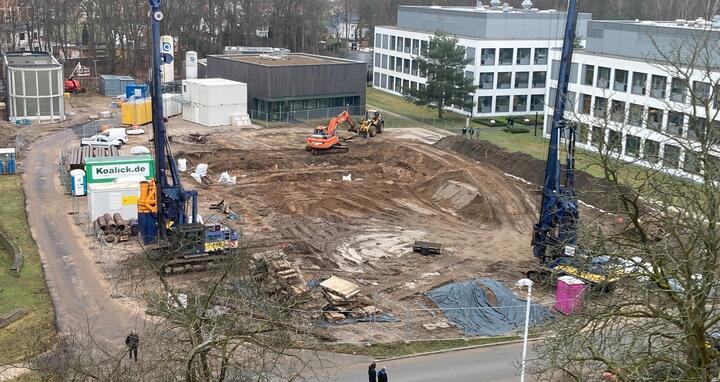Construction begins on new Imaging Innovation Center
Since January 16 of this year, the low and steady rumble of construction vehicles has been emanating from the north end of Campus Berlin-Buch. Workers are in the process of digging a new foundation pit in front of the building for cryo-electron microscopy (cryo-EM), in between Building 87 and the Leibniz-Forschungsinstitut für Molekulare Pharmakologie (FMP). In two years’ time, this site will be home to the Max Delbrück Center’s Imaging Innovation Center (IIC) – previously known by its working title, the Optical Imaging Center. Here, technology platforms and research labs working in the field of microscopy will be brought together under one roof.
The IIC will be a place where researchers further develop microscopy technologies and image analysis methods and make these technologies and methods available to other scientists.
“The IIC will be a place where researchers further develop microscopy technologies and image analysis methods to help them find answers to their biomedical questions – and make these technologies and methods available to other scientists,” says Dr. Jutta Steinkötter, who heads the Scientific Infrastructure Department. “As part of the Max Delbrück Center’s last scientific evaluation in 2012, it was recommended that the Center position itself even more broadly in terms of advancing microscopy imaging,” she explains, adding: “We now want to implement this recommendation.” The Max Delbrück Center already has plenty to show for its efforts to push the envelope in microscopy: In 2008, the Advanced Light Microscopy Platform was launched, headed by Dr. Anje Sporbert, which is now used by two-thirds of the Center’s researchers as well as external project partners. In addition, the Max Delbrück Center has expanded its collaborations in electron microscopy with the FMP, and now operates the Cryo-EM Platform in cooperation with Charité – Universitätsmedizin Berlin and the FMP. The Image Data Analysis Platform, headed by Deborah Schmidt, is one of three service units of the Helmholtz Imaging initiative, where researchers across the Helmholtz Association can receive free support with imaging-related matters and can network with each other. Last but not least, Dr. Andrew Woehler has set up the Systems Biology Imaging Platform at the Berlin Institute for Medical Systems Biology of the Max Delbrück Center (MDC-BIMSB). These platforms are all rich sources of data that have already made a substantial contribution to numerous MDC publications through their methods, analyses and results.
Expanding the use of high-resolution microscopy in research
The IIC will bring together physicists, biophysicists, life scientists and bioinformaticians. In addition to the teams of the Advanced Light Microscopy Platform, the Cryo-EM Platform, and the Image Data Analysis Platform, other research groups will also move into the building – exactly which ones will be decided by a scientific committee. Together, they will develop new microscopy technologies and make them available for wider biomedical research. Of particular interest to the Max Delbrück Center research groups will be methods with high temporal and spatial resolution, imaging techniques for individual molecules, and correlative methods.
Visualisation of the Imaging Innovation Center (IIC)
But there is still a lot of earth to be moved on campus before that point is reached. A truck garage and a long workshed previously stood on the site of the new foundation pit, and old electrical cables, heating and cooling pipes are still hidden in the ground. The excavators have also unearthed building rubble containing asbestos and other pollutants, which is causing delays to the planned schedule. “The disposal of such materials is strictly regulated,” explains project manager Karsten Hönig, an architect in the Technical Facility Management Department. “We have to collect samples and have them analyzed, which makes everything take a little longer.” The contract for construction of the building’s shell is currently being finalized and eleven companies have submitted bids – which, according to Hönig, is a lot: “The housing market crisis is working in our favor, but inflation is also affecting construction costs.”
Architectural firm Heinle Wischer is responsible for the design of the future IIC. The company has already realized several projects on Campus Berlin-Buch: the Max Delbrück Communications Center (MDC.C), the Research Institutes for Experimental Medicine (FEM), the FMP, and the cryo-EM building. The first master plan for the campus itself was also penned by Heinle Wischer. Like the cryo-EM building, the IIC will be built on a thick foundation slab designed to cancel out vibrations. Together with a vibration-resistant support structure, this will protect the sensitive microscopes from the regular ground tremors of the city. Meanwhile, a high-precision ventilation system will ensure a stable temperature and constant humidity in the microscopy labs.
The foundation stone is expected to be laid in the first half of 2023.
Text: Jana Ehrhardt-Joswig






